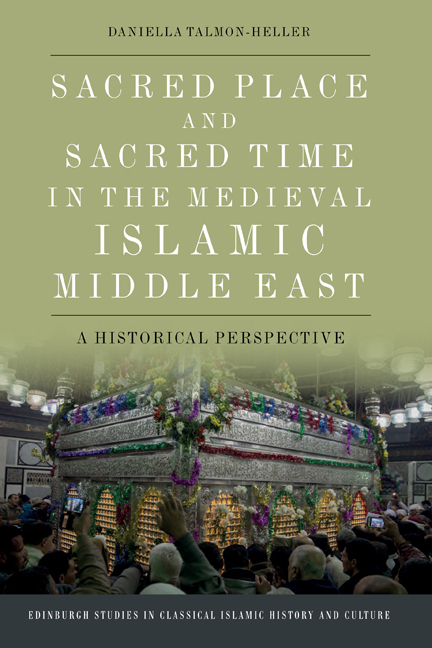Book contents
- Frontmatter
- Contents
- List of Figures
- Acknowledgements
- Map of the Middle East
- Introduction
- 1 Etic Concepts and Emic Terms
- 2 The State of the Art
- Part One A Sacred Place: The Shrine of al-Husayn’s Head
- Part Two A Sacred Time: The Month of Rajab
- Final Comments: Spacial and Temporal Sanctity
- Works Cited
- Index
Introduction
Published online by Cambridge University Press: 17 October 2020
- Frontmatter
- Contents
- List of Figures
- Acknowledgements
- Map of the Middle East
- Introduction
- 1 Etic Concepts and Emic Terms
- 2 The State of the Art
- Part One A Sacred Place: The Shrine of al-Husayn’s Head
- Part Two A Sacred Time: The Month of Rajab
- Final Comments: Spacial and Temporal Sanctity
- Works Cited
- Index
Summary
Then in the distance they could see part of the exterior of the mosque of al- Husayn. In the center was an expansive window decorated with arabesques … With joy singing in her breast, she asked: ‘Our master al-Husayn?’ He confirmed her guess. Her pace quickened for the first time since she left the house. She began to compare what she saw with the picture created by her imagination and based on what she had seen from her home of mosques like Qalawun and Barquq. She found the reality to be less grand than she had imagined. In her imagination she had made its size correspond to the veneration in which she held its holy occupant. This difference between imagination and reality, however, in no way affected the pervasive intoxication of her joy at being there … They entered … She felt that her body was dissolving into tenderness, affection and love and that she was being transformed into a spirit fluttering in the sky, radiant with the glow of prophetic inspiration. Her eyes swam with tears that helped relieve the agitation of her breast, the warmth of her love and belief, and the flood of her benevolent joy. She proceeded to devour the place with greedy, curious eyes: the walls, ceiling, pillars, carpets, chandeliers, pulpit, and the mihrab niches indicating the direction of Mecca … How often had she wished to visit this site … Here she was standing within the shrine. Indeed, here she was touching the walls of the tomb itself … She stroked the walls and kissed them. (Naguib Mahfouz, Palace Walk)
Mahfouz's moving description of an Egyptian housewife's visit to the al- Husayn Shrine in Cairo was written in the mid-1900s. It captures the ‘magnetism’ of the holy place and the over-whelming emotion and bodily sensations of a believer upon entering it for the first time after years of desire and anticipation. The author skillfully portrays the shrine's impact on Amina, the housewife in Bayna al-Qaṣrayn, known in English as The Cairo Trilogy.
- Type
- Chapter
- Information
- Sacred Place and Sacred Time in the Medieval Islamic Middle EastA Historical Perspective, pp. 27 - 28Publisher: Edinburgh University PressPrint publication year: 2020



